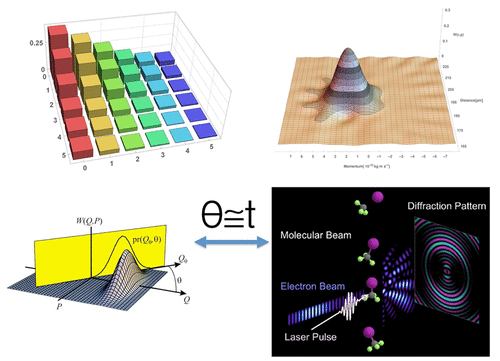当前位置:
X-MOL 学术
›
ACS Photonics
›
论文详情
Our official English website, www.x-mol.net, welcomes your
feedback! (Note: you will need to create a separate account there.)
Mapping Atomic Motions with Electrons: Toward the Quantum Limit to Imaging Chemistry
ACS Photonics ( IF 6.5 ) Pub Date : 2020-01-09 , DOI: 10.1021/acsphotonics.9b01008 Zheng Li 1, 2 , Sandeep Gyawali 3 , Anatoly A. Ischenko 4 , Stuart Hayes 2 , R. J. Dwayne Miller 2, 5
ACS Photonics ( IF 6.5 ) Pub Date : 2020-01-09 , DOI: 10.1021/acsphotonics.9b01008 Zheng Li 1, 2 , Sandeep Gyawali 3 , Anatoly A. Ischenko 4 , Stuart Hayes 2 , R. J. Dwayne Miller 2, 5
Affiliation

|
Recent advances in ultrafast electron and X-ray diffraction have pushed imaging of structural dynamics into the femtosecond time domain, that is, the fundamental time scale of atomic motion. New physics can be reached beyond the scope of traditional diffraction or reciprocal space imaging. By exploiting the high time resolution, it has been possible to directly observe the collapse of nearly innumerable possible nuclear motions to a few key reaction modes that direct chemistry. It is this reduction in dimensionality in the transition state region that makes chemistry a transferable concept, with the same class of reactions being applicable to synthetic strategies to nearly arbitrary levels of complexity. The ability to image the underlying key reaction modes has been achieved with resolution to relative changes in atomic positions to better than 0.01 Å, that is, comparable to thermal motions. We have effectively reached the fundamental space-time limit with respect to the reaction energetics and imaging the acting forces. In the process of ensemble measured structural changes, we have missed the quantum aspects of chemistry. This perspective reviews the current state of the art in imaging chemistry in action and poses the challenge to access quantum information on the dynamics. There is the possibility with the present ultrabright electron and X-ray sources, at least in principle, to do tomographic reconstruction of quantum states in the form of a Wigner function and density matrix for the vibrational, rotational, and electronic degrees of freedom. Accessing this quantum information constitutes the ultimate demand on the spatial and temporal resolution of reciprocal space imaging of chemistry. Given the much shorter wavelength and corresponding intrinsically higher spatial resolution of current electron sources over X-rays, this Perspective will focus on electrons to provide an overview of the challenge on both the theory and the experimental fronts to extract the quantum aspects of molecular dynamics.
中文翻译:

用电子映射原子运动:朝着成像化学的量子极限发展
超快电子和X射线衍射的最新进展已将结构动力学的成像推向了飞秒时域,即原子运动的基本时标。超越传统衍射或互易空间成像的范围,可以达到新的物理学。通过利用高时间分辨率,可以直接观察到几乎无数可能的核运动向指导化学反应的一些关键反应模式的崩溃。正是由于过渡态区域中维数的减少,使得化学成为可转移的概念,同一类反应适用于几乎任意程度的复杂性的合成策略。可以实现对基本关键反应模式成像的功能,并且可以将原子位置的相对变化解析为优于0的分辨率。01Å,相当于热运动。我们已经有效地达到了关于反应能和对作用力进行成像的基本时空限制。在整体测量的结构变化过程中,我们错过了化学的量子方面。该观点回顾了在行动中成像化学的最新技术,并提出了获取动力学方面的量子信息的挑战。当前的超高亮电子和X射线源至少在原理上有可能以Wigner函数和密度矩阵的形式对振动,旋转和电子自由度进行量子态的层析成像重建。访问此量子信息构成了对化学互易性空间成像的时空分辨率的最终要求。考虑到当前电子源在X射线上的波长要短得多,并且固有地具有更高的空间分辨率,因此本“透视图”将重点关注电子,以概述在理论和实验前沿方面都面临的挑战,以提取分子动力学的量子方面。
更新日期:2020-01-09
中文翻译:

用电子映射原子运动:朝着成像化学的量子极限发展
超快电子和X射线衍射的最新进展已将结构动力学的成像推向了飞秒时域,即原子运动的基本时标。超越传统衍射或互易空间成像的范围,可以达到新的物理学。通过利用高时间分辨率,可以直接观察到几乎无数可能的核运动向指导化学反应的一些关键反应模式的崩溃。正是由于过渡态区域中维数的减少,使得化学成为可转移的概念,同一类反应适用于几乎任意程度的复杂性的合成策略。可以实现对基本关键反应模式成像的功能,并且可以将原子位置的相对变化解析为优于0的分辨率。01Å,相当于热运动。我们已经有效地达到了关于反应能和对作用力进行成像的基本时空限制。在整体测量的结构变化过程中,我们错过了化学的量子方面。该观点回顾了在行动中成像化学的最新技术,并提出了获取动力学方面的量子信息的挑战。当前的超高亮电子和X射线源至少在原理上有可能以Wigner函数和密度矩阵的形式对振动,旋转和电子自由度进行量子态的层析成像重建。访问此量子信息构成了对化学互易性空间成像的时空分辨率的最终要求。考虑到当前电子源在X射线上的波长要短得多,并且固有地具有更高的空间分辨率,因此本“透视图”将重点关注电子,以概述在理论和实验前沿方面都面临的挑战,以提取分子动力学的量子方面。











































 京公网安备 11010802027423号
京公网安备 11010802027423号